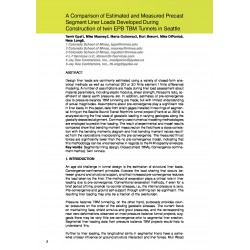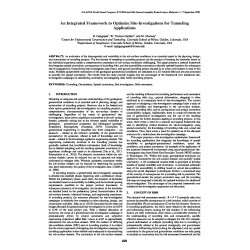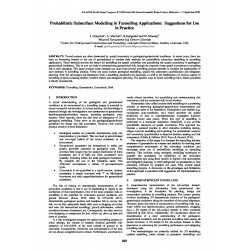No document
Search & filter
Search for a publication
Search & filter
List of products by author: M. Mooney
-
A Comparison of Estimated and Measured Precast Segment Liner Loads Developed During Construction of twin EPB TBM...
Abstract: Design liner loads are commonly estimated using a variety of closed-form analytical methods as well as numerical (2D or 3D fnite element / fnite difference) modeling. A number of assumptions are made during liner load assessment about material parameters, including elastic modulus, shear strength, Poisson’s ratio, coeffcient of lateral earth pressure, etc. In addition, estimates of...
0,00 € -
An Integrated Framework to Optimize Site-Investigations for Tunneling Applications
Abstract: An evaluation of the heterogeneity and variability in the sub-surface conditions is an essential aspect in the planning, design, and construction of tunneling projects. The low density of sampling in tunneling projects and the practice of locating the boreholes based on the individual experience makes a comprehensive assessment of sub-surface conditions challenging. This paper presents a...
0,00 € -
Applying machine learning for ground type detection using monitored earth pressure
Abstract: Geological uncertainty poses significant risk for soft ground tunnelling. The current ground mapping relies on a few boreholes to estimate the geology along the tunnel alignment via either expert judgment or geostatistical modelling, which is inevitably uncertain due to borehole sparsity. As earth pressure balance tunnel boring machine (EPBM) behaviour changes in various grounds and are...
0,00 € -
Experimental evaluation of soil-foam mixing under pressure
Abstract: EPB TBM tunneling often relies upon the assumption of homogeneous conditioned soil in the tool gap of the cutterhead. Such a conditioned soil zone ensures that impermeability is maintained, that torque is lowered, and that the pressure from excavation chamber equilibrates in the tool gap, minimizing force on the cutterhead. Foam injection at the cutterhead occurs through a discrete number of...
0,00 € -
Influence of slurry TBM parameters on ground deformation
Abstract: Tunnelling in soft ground can induce considerable ground deformation that poses a risk to existing infrastructure. To control ground deformation, pressurized-face tunnel boring machines (TBMs) (e.g., slurry shield and earth pressure balance (EPB)) are increasingly employed in urban areas. The effect of support pressures applied at the tunnel face and circumference have an important influence on...
0,00 € -
Probabilistic Subsurface Modelling in Tunnelling Applications: Suggestions for Use in Practice
Abstract: Tunnel projects are often dominated by spatial uncertainty in geological-geotechnical conditions. In recent years, there has been an increasing interest in the use of geostatistical or random field methods for probabilistic subsurface modelling in tunnelling applications. These methods provide the means for modelling the spatial variability and quantifying the spatial uncertainty in...
0,00 € -
Tunnel Process Control for Klang Valley Metro Phase 2 Using Machine Learning and Artificial Intelligence
Abstract: The Klang Valley Mass Railway Transit in Kuala Lumpur is mid-way through line 2 construction. The line faces several challenges including mixed face conditions, variable ground water and geologic hazards with high potential for large settlements and sink holes. Consequently, the influences on tunnel processes such as advance rates and cutter tool wear are hard to estimate. This paper presents...
0,00 €







